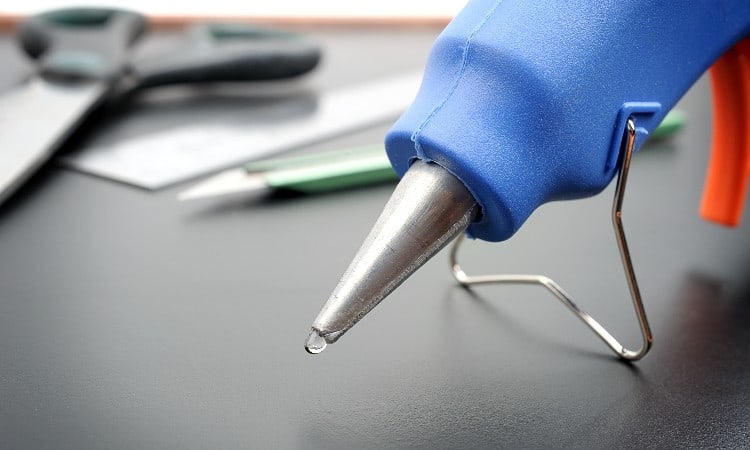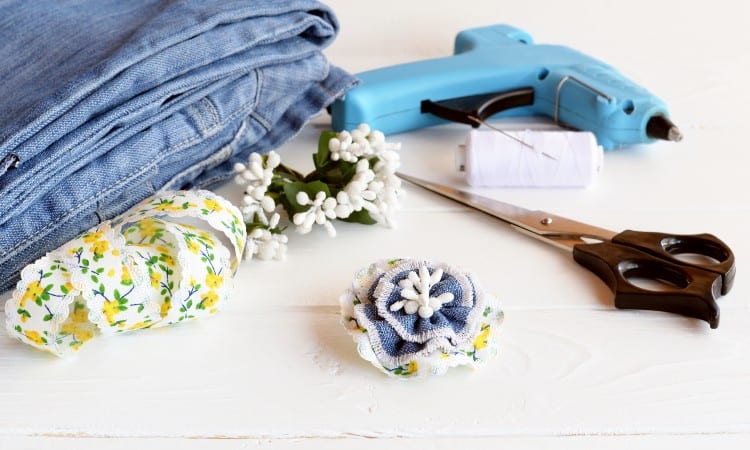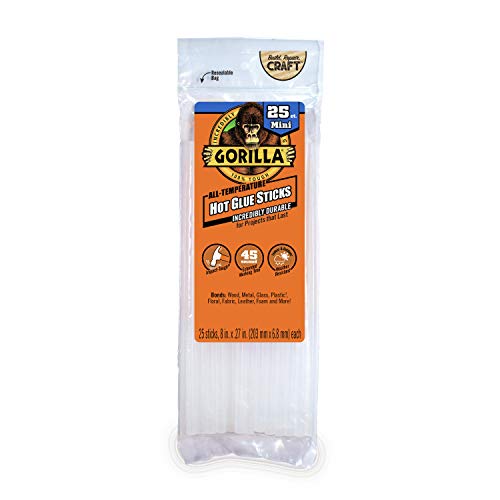Have you, at any time, experienced an unexpected tear of fabric and needed a quick fix? I’m sure hot glue crossed your mind. But if you held back, wondering if hot glue works on fabric, I guarantee you this article has all the answers.
Hot glue does work to hold pieces of fabric together. It is not a long-term solution, but it often offers the immediate solution you’re looking for. Choosing the right type of glue and gun is key to successful bonding. Gluing your fabric together with hot glue is a pretty simple process. Pocket-friendly and efficient, hot glue does its work on fabric within hours.
In this article, we’ll tell you all about the choices of glue available in the market and how they are made. We’ll also tell you what type of hot-glue gun works for different types of fabric.

What Is Hot Glue?
When you think of hot glue, you probably associate it with glue guns and glue sticks, crafts, and DIY projects. But is your regular glue stick the same as hot glue?
Regular glue sticks are solid adhesives available in twist-up tubes. These are great for everyday use and minor applications.
Hot glue or Hot Melt Adhesives (HMA) are made using a combination of polymers and additives such as resins, waxes, and plasticizers. These elements are heated together and then cooled down to set. Some HMAs are also incorporated with antioxidants responsible for preserving the adhesive even in high temperatures.
A thermoplastic polymer provides adhesive strength and flexibility to the hot glue. The resins supply that instant hot-tack of the glue while the wax thins out the bond so it can be thoroughly and conveniently applied.
Hot glue works in a molten state. That explains the need for a glue gun. A glue gun is used to melt the glue stick, making hot glue work.
The versatile hot glue is used in many aspects, including building and construction, packaging and sealing, school projects and decorations. It is a must-have for every home and one that you can always grab for easy solutions.
How Does Hot Glue Work?

Hot glue works are primarily used to bond objects of the same or varying materials. It is applied on one of the surfaces in a liquid or molten state. And it sets or works by the loss of heat.
After an “open time” or the time spent applying hot glue on the first material and getting the second material in contact, the hot glue cools down, sets, and solidifies. This simple process bonds the two materials together.
After these crucial seconds, compressing the materials together is necessary to ensure that the two materials are well bonded together.
To make hot glue work successfully, you must consider a few factors.
- The temperature should be hot enough that the glue viscosity is low to sufficiently wet the substrates and the materials bonded before cooling.
- The compression or pressure applied should be enough to laminate the substrates securely. This significantly impacts the bond to the second object as well.
- The add-on level is the amount of hot glue applied at a given time. This impacts the adhesive’s wet-out to the secondary object. The more hot glue you use, the longer the cooling period.
- The open time impacts the hot glue’s temperature and add-on level. The longer the open time, the more pressure you need for compression because the hot glue is no longer viscous.
- The substrates are the two objects that you are binding with the adhesive. Substrates that are highly textured allow better mechanical adhesion.
Does Hot Glue Work on Fabric?
Applying hot glue on fabric seems to be a quick solution for art, craft, and household needs. The good news is, hot glue works on fabric, but you need to be careful about applying it.
It is best to use low-temperature hot glue guns on fabric because they melt and apply the hot glue at a lower and more fabric-friendly temperature.
Can You Use Hot Glue Instead Of Sewing?
Using glue is definitely a time saver. It cuts your time spent on your projects by more than half.
But can you just glue and not sew?
Hot glue is not a suitable replacement for sewing. It serves as a temporary solution. You may go ahead and use hot glue, but sooner or later, you’d still want to sew your fabrics together.
Sewing your fabrics is better because the binding lasts longer. The finished product also looks and feels better than it was simply glued together. Sewing is the most secure method to fasten your fabrics, especially if these fabrics are exposed to plenty of flexing and movement—activities that can, unfortunately, break the glue bonds.
Additionally, hot glue is not effective on some fabrics, so you are automatically limited with the textiles that you can work on.
Do Hot Glue Ruin Clothes?
This depends on the fabric. Clothes made of certain materials cannot take the heat of hot glue.
Even if you use a low-temperature hot glue gun, there is still a risk of ruining the fabric.
Working with acrylic, wool, and modal acrylic, you won’t have any problems bonding them with hot glue because these fabrics can handle the heat. Leather can handle heat well too, but subjecting it to glue may cause it to smell bad, so be prepared.
Textiles made of cotton, linen, and viscose can handle hot glue well, but you need to be very careful with the application and add-on level. Putting in too much hot glue poses a risk of damaging the fabric.
You can use hot glue on polyester, but you must apply it carefully as this fabric tends to melt quickly.
Hot glue is a no-no for nylon, as it will completely ruin the fabric.
How to Use Hot Glue On Fabric

Using and applying hot glue on fabric is not hard at all. Just ensure your fabric can tolerate heat, pick the right type of gun, and use great application and compression techniques.
Here is a refresher on how to use hot glue on the fabric.
#1. Know your products
Aside from knowing how to use a hot glue gun properly, you also need to know which kind of hot glue gun to use.
Opt for a low-temperature hot glue gun when planning to bind fabrics together.
Sure, you can use the regular glue gun for most gluing jobs, but it is best to use the particular low-temperature hot glue gun if working with fabric.
The typical hot glue guns are also referred to as high-temperature hot glue guns. These devices automatically heat the hot melt adhesive to 383°F (195°C).
On the other hand, low-temperature hot glue guns don’t go beyond 266°F (130°C) while still functioning in terms of binding the two fabric substrates together. These are still hot glue guns that need low-temperature hot glue sticks. You cannot use your regular glue stick in these guns as they will not melt.
If you plan to use your glue gun for multipurpose projects, you will do well to purchase a dual-temperature hot glue gun. As the name suggests, you can use this for fabric and other materials because you can set it to high or low-temperature settings.
#2. Applying the hot glue to the textile
Now that you know the right products to use and the heat tolerance of the most common fabrics, you can now glue your fabric together.
First, apply a thin line of your hot melt adhesive along the line, edge, or place where you want to glue the material.
If you are trying to glue two textile pieces together, then directly apply the glue to the fabric that best handles the heat.
And if the area of fabric you are working on is quite large, it is better to glue it together several times, partitioning that entire surface. Adapt a divide and conquer approach—one inch of the fabric at a time.
Remember that applying the hot glue all at once on the entire area will cause other surfaces to cool down already, so you won’t be able to use proper and effective compression all at once.
#3. Compressing it together
While the glue is still hot, press the fabrics against each other. If possible, use materials to press and weigh the two fabrics together, like a stack of books or a fabric clamp.
Never press the fabric with hot glue using your hands. Else you end up with a mess of detached fabrics and some painful burned fingers.
You have to work quickly when pressing the fabrics together because the hot glue takes only a couple of seconds to start hardening. You want to bind the two fabrics together while the glue is still sweltering hot to create a strong bond from the start.
How Long Does It Take for Hot Glue to Dry on Fabric?
One of the advantages of using hot glue is its time efficiency. It dries fast.
When applied to fabric, hot glue can take up to 1 to 10 minutes to dry. It would take at least 24 hours for the glue to be cured entirely.
Can You Use Hot Glue On Fabric And Wash It?
This is one of the most common questions when using hot glue on the fabric.
Yes, you can wash your clothes or any fabric on which you have used hot glue. The fabric will remain bonded after you do your laundry.
Low-temperature hot glue will start melting when exposed to a temperature of at least 266°F or 130°C. When being washed, this temperature is far from being obtained, so you don’t need to worry about the seams and edges falling apart.
Although the glue will not melt, frequent fabric washing with hot glue will weaken the binding. Handwashing fabrics with hot glue is a good option. Still, the hot glue holding the two materials together will deteriorate over time.
Hot Glue vs. Fabric Glue
Hot glue and fabric glue can both be used to bind two fabrics together. Most crafters and DIY enthusiasts would have both of these in their kits.
As the name suggests, fabric glue is specifically designed for fabrics with significantly thinner textiles. It usually dries clear and is 100% washable. Most fabric glues are also intended to be permanent, so application should be done with caution.
Fabric glue is also used not just for fabrics but also for adding embellishment and different adornments into a fabric.
On the other hand, hot glue works well with both thin fabrics and thicker ones like leather and even heavy gold braids.
Both of these adhesives work well, provided they are used on the right kind of fabric. Fabric glue tends to leave dark spots on silky materials, while hot glue is known to leave gluey string trailing everywhere.
What Is The Best Hot Glue For Fabric?
 When it comes to bonding fabrics, you have to keep an eye for the best hot glue on the market. There are plenty of choices, each promising to be the best of the best, but a clear winner, for me, based on experience, is the Gorilla Hot Glue Sticks.
When it comes to bonding fabrics, you have to keep an eye for the best hot glue on the market. There are plenty of choices, each promising to be the best of the best, but a clear winner, for me, based on experience, is the Gorilla Hot Glue Sticks.
Here are the three reasons you should use it and add it to your current DIY stash.
It is a hot glue for all trades.
The Gorilla Hot Glue stick can be used for high and low-temperature glue guns. Being an all-temperature hot melt adhesive, you control its thickness or viscosity. You can use it not just for fabric but also for other materials and projects.
It is intended for general purpose use.
This is not your cheap craft store hot glue. The Gorilla Hot Glue Sticks stick is formulated and tested to work with various materials and substrates. Aside from fabric, you can also use it on metal, foam, wood, and even on some plastics.
It is pocket-friendly.
You don’t need to purchase different hot glue for specific crafts and projects anymore. This product is suitable for most projects and, what’s more, it is affordable.
Conclusion
Now you know that hot glue can also be a reliable alternative when working with fabric.
If you work with fabrics frequently, it pays to know different binding methods.
This information is very handy during emergencies as it is a quick solution to snags and hitches.
We hope you enjoyed this article. Share it with your friends if so!